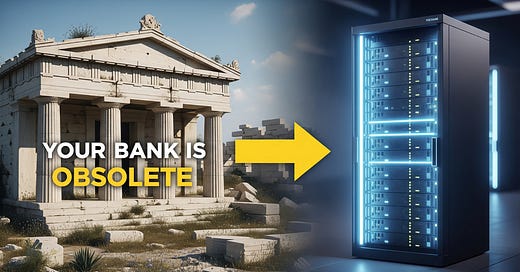Have you ever looked at your savings account and felt a little… underwhelmed? That feeling of your money just sitting there, barely growing, while the world of finance seems to be moving at light speed somewhere else. I’ve been there. It sparked a journey into a new corner of the internet, a place where the old rules of money are being rewritten. It’s called Decentralized Finance, or DeFi, and it offers a different way to think about your assets. If you’re ready to move from being a passive spectator to an active participant in your financial life, this article is for you. We’ll explore three core concepts that can help you put your money to work, unlock its potential, and access new opportunities. It might be the perfect read to share with that friend who’s always curious about the future of tech and finance. For a quick visual recap, be sure to scroll to the end for a helpful infographic. Now, let’s dive in.
🎁Episode Bonuses for our Monthly and Annual Plan Subscribers
DeFi Lending Comparison Chart
Safe Borrowing Planner (free to everyone)
DEX Swap Safety Guide
Navigating the DeFi Frontier ebook
1. THE LENDER'S YIELD
Idle capital erodes—active capital earns.
Do you ever wish your money could do more than just exist? In the traditional system, when you deposit money in a bank, the bank lends it out and earns interest, giving you a tiny fraction of the profits. What if you could cut out the middleman and become the bank yourself? That’s the essence of DeFi lending. Instead of lending your money to a specific person, you contribute your crypto assets to a large, shared pot called a liquidity pool. Think of it as a community fund managed by automated code. Borrowers can then take loans from this pool, and the interest they pay is distributed directly to you and the other contributors. The interest rates aren't set by a board in a stuffy room; they’re dynamic, adjusting in real-time based on simple supply and demand. When lots of people want to borrow, rates go up, and you earn more. When demand is low, rates go down. It’s a transparent system where your assets are constantly working for you, 24/7, without asking for a day off.
It’s like a community water co-op.
Imagine a village with a massive, shared water tank. Anyone with extra water can pour it into the tank. In return, they get a special token for every gallon they contribute. When someone needs water, they go to the tank and pay a small fee to fill their bucket. That fee is automatically distributed among all the token holders. The more people who need water, the higher the fee becomes, and the more everyone with a token earns. You’re not lending to a specific neighbor; you’re providing liquidity to the whole community and earning a reward for it.
What It Looks Like In Action
Maya sat across from her friend Ben at their favorite coffee shop, swirling the foam in her latte. "I just feel like my savings are collecting dust," she said, frustrated. "The interest rate is a joke. It’s not even keeping up with inflation."
Ben leaned forward. "You know how I've been exploring that DeFi stuff? There’s something you might find interesting. It’s called lending. You can take stablecoins—digital dollars, basically—and deposit them into a protocol. You start earning yield immediately, way more than any bank offers."
"Isn't that risky? Like, who am I lending my money to?" Maya asked, skeptical.
"That's the cool part," Ben explained. "You're not lending it to one person. You're adding it to a big pool of money that the protocol manages. Borrowers take loans from that pool and have to put up their own crypto as collateral, more than what they borrow. It’s all handled by code. You can watch your earnings grow in real-time and pull your money out whenever you want."
Maya pulled out her phone. "Okay, show me. If my money is just going to sit there, it might as well be working."
Remember:
Since bank interest rarely beat inflation, using DeFi pools boosts earnings.
Do It:
Start Small. Just as Maya didn't empty her entire bank account, you shouldn't either. Begin by researching and transferring a small, experimental amount of money you are comfortable losing into a stablecoin like USDC. Think of it as tuition for your financial education.
Choose Wisely. Not all lending platforms are created equal. Spend time on a trusted information site like CoinGecko or DeFi Llama to compare the top lending protocols like Aave or Compound. Look at their security history, the total value of assets they manage, and the current yields they offer.
Track Actively. This isn't a 'set it and forget it' savings account. Connect your wallet to a portfolio tracker or simply bookmark your position on the protocol's dashboard. Check in weekly to understand how the yield fluctuates with market demand and to stay informed about your investment.
🎁BONUS RESOURCE - For Our Monthly and Annual Substack Subscribers: Use the DeFi Lending Comparison Chart recourse. It’s a side-by-side overview of top lending protocols like Aave, Compound, and Morpho with yield rates, security audits, and supported assets. You’ll find it in the Not Theoretical Bonus Resource Library under today’s article name.
2. THE BORROWER'S LEVERAGE
Hold what you own, borrow what you need.
Have you ever been in a position where you needed cash but the only way to get it was to sell something you truly believed in—a stock, a family heirloom, or in this case, a crypto asset? It’s a painful choice, forcing you to sacrifice future potential for present needs. DeFi borrowing offers an alternative path. It allows you to use your digital assets as collateral to take out a loan. This means you can get the liquidity you need—to pay for an emergency, invest in a new opportunity, or buy a major purchase—while still holding onto your original assets, retaining all their potential for future growth. The process is nearly instant and requires no credit checks or lengthy applications. Your assets are your credit. As long as the value of your collateral stays safely above the value of your loan, you’re in control. It’s a powerful way to make your assets flexible and multi-purpose.
It’s like an automated pawn shop.
You bring in a valuable vintage watch. Instead of a person behind a counter, you place it in a secure, transparent vault. A laser scans it, checks its real-time market value against a global database, and instantly offers you a cash loan worth 70% of its value. A large screen on the vault displays your watch’s value, which fluctuates with the market. As long as the value stays high, you’re fine. But if it drops to a pre-set danger level, the vault automatically lists the watch for sale to an online collector to cover your loan before it loses more value.
What It Looks Like In Action
Liam, a freelance graphic designer, stared at the quote for a new high-performance computer. It was exactly what he needed to take on bigger projects, but it was a major expense. He had a decent amount of Ethereum that he’d been holding for years, and he was convinced it would be worth much more in the future. Selling it felt wrong.
He called his sister, Chloe, who was more into the tech scene. "I'm in a bind," he said. "I need cash for a new rig, but I really don't want to sell my ETH."
"You don't have to," Chloe said immediately. "You can use it as collateral. Go to a protocol like Compound, deposit your ETH, and you can borrow stablecoins against it. Then you just cash out the stablecoins to your bank account."
"Wait, so I get the cash, and I still own my ETH?" Liam asked, intrigued.
"Exactly. You just have to manage your loan. The platform shows you a 'Health Factor.' As long as you keep that in a safe zone by not borrowing too much, you're golden. If the price of ETH drops and your health factor gets low, you can add more collateral or pay back some of the loan. It gives you options without forcing you to sell."
A week later, Liam was setting up his new computer, paid for with a loan against his assets, which were still safely in his possession.
Remember:
If selling locks in regret, then borrowing lets you keep upside while accessing cash.
Do It:
Assess Need. Before you borrow, be clear on your purpose. Like Liam, you should have a specific goal, whether it's for an investment, a necessary purchase, or an emergency. Avoid borrowing simply for the sake of it.
Prioritize Safety. Never borrow the maximum amount available. This is the most common and dangerous mistake. Give yourself a large buffer. Aim to keep your loan's Health Factor high to protect yourself from liquidation during market volatility.
Set Alerts. Use a crypto portfolio app or even a simple price alert app on your phone. Set an alert for the price of your collateral asset that is well above its liquidation price. This acts as an early warning system, giving you time to add collateral or repay part of the loan if the market turns against you.
🎁BONUS RESOURCE - For Everyone: Safe Borrowing Planner. Use this checklist to assess your loan health factor, collateral ratios, and set liquidation alerts. Includes best practices for each asset type.
3. THE TRADER'S ARENA
Skip the queues—trade on your terms.
Think about the last time you wanted to buy something new and exciting—a niche product, a ticket to an indie band. Often, you have to wait for it to become available in a mainstream store. The world of finance is similar. Promising new projects and assets often take months or years to get listed on major, centralized exchanges. By then, the earliest opportunity may have passed. Decentralized Exchanges, or DEXs, change this dynamic entirely. They are open marketplaces that use the same liquidity pools we discussed in lending. Anyone can create a market for any two assets, meaning you can often find and trade new tokens long before they hit the mainstream. There are no accounts to create, no verification to wait for, and no central company that can freeze your funds. You trade directly from your own wallet. It’s a direct, unfiltered, and immediate way to engage with the market.
It’s like a magical, 24/7 farmer's market in the center of a town square.
Instead of individual stalls, there are pairs of large, connected fountains—one for apples, one for oranges; one for wheat, one for corn. There are no farmers present. If you want oranges, you simply toss your apples into the apple fountain, and the orange fountain automatically dispenses the correct amount of oranges based on how many of each are in the fountains. The price is simply the ratio of apples to oranges at that exact moment. Anyone can even start a new pair of fountains if they have both assets to contribute. It’s a completely automated and open system for exchange.
What It Looks Like In Action
Chloe was deep into her research on a new green energy project built on the blockchain. The project's token was about to launch, but only on a decentralized exchange called Uniswap. All her friends who used traditional exchanges would have to wait weeks, if not months.
She transferred some of her funds to her MetaMask wallet, navigated to the Uniswap site, and connected her wallet. The interface was simple: a "from" field and a "to" field. She selected ETH in the "from" field and pasted the new token's official contract address—which she had carefully copied from the project's official channel—into the "to" field.
Her friend Liam texted her. "Is it complicated? I've only ever used Coinbase."
"Not at all," she texted back. "It's like a vending machine. I put one thing in, I get another thing out. I just have to set my 'slippage tolerance'—basically, how much I'm willing to let the price shift before my order cancels—and pay the network fee. It's direct, me to the code. No middleman."
A few clicks later, the transaction was confirmed. The new tokens were in her wallet. She was an early supporter of a project she believed in, long before it hit the mainstream headlines.
Remember:
If centralized exchanges delay listings, trading on DEXs means you act first.
Do It:
Verify First. The greatest risk on DEXs is trading fake tokens. Before you swap for a new asset, always find its official contract address from a trusted source like the project's official website or a reputable data aggregator like CoinGecko. As Chloe did, copy and paste this address directly.
Mind Slippage. When you trade, especially larger amounts, your own transaction can move the price. In the DEX interface, set a reasonable slippage tolerance (usually 0.5% to 1% is fine for major assets). This protects you from getting a much worse price than you expected if the market is volatile.
Use a Test Transaction. If you are moving a significant amount of money or are new to the process, send a tiny amount first. Yes, you'll pay the network fee twice, but the peace of mind from seeing the test transaction go through successfully is invaluable.
🎁BONUS RESOURCE - For Our Monthly and Annual Substack Subscribers: DEX Swap Safety Guide. A mini-guide on safely using Uniswap or SushiSwap: how to verify token addresses, set slippage tolerance, and do a test swap. You’ll find it in the Not Theoretical Bonus Resource Library under today’s article name.
TYING IT TOGETHER
DeFi turns your assets into action.
At first glance, lending, borrowing, and trading might seem like separate financial actions. But in the world of DeFi, they are deeply interconnected threads in a single, powerful fabric. The capital you earn from lending can become the collateral you use for borrowing. The loan you take out can be the funds you use for a strategic trade on a DEX. And the assets you acquire from that trade can, in turn, be put back to work in a lending pool, starting the cycle anew. This is the composability—the "money lego"—aspect of DeFi that makes it so dynamic.
By understanding these three pillars, you’re not just learning about isolated tools; you’re learning the grammar of a new financial language. The insights in this article were drawn from a comprehensive deep research report on the mechanics of Decentralized Finance. Now it’s your turn to put one of these concepts into practice. Start with one, get comfortable, and see how it feels to have more direct control over your financial life.
Have you tried one of these already? Share your experience or questions in the comments below. And if you found this guide helpful, be sure to follow us for more deep dives into the technology shaping our future.
Now, keep scrolling for a visual summary of what you’ve just learned!
Remember:
Because inefficiencies exist in traditional finance, DeFi empowers you to lend, borrow, and trade directly.
🎁Monthly and Annual Plan Subscriber Bonus
1. Navigating the DeFi Frontier ebook
A complete 40 page beginner's guide explaining foundational DeFi concepts , comparing them to traditional finance , and offering practical, step-by-step tutorials for lending , borrowing , and trading , which helps newcomers understand and safely begin interacting with the ecosystem. You’ll find it in the Not Theoretical Bonus Resource Library under today’s article name.
You can unsubscribe in one click.
Disclaimer:
This publication is for informational purposes only and does not constitute financial, investment, legal, or tax advice. The information contained herein reflects the views and interpretations of the author as of the date of publication and is subject to change without notice. Not Theoretical LLC makes no representations or warranties regarding the accuracy, completeness, or suitability of this content for any particular purpose. Readers should conduct their own research and consult with a qualified financial advisor before making any investment decisions.





















Share this post